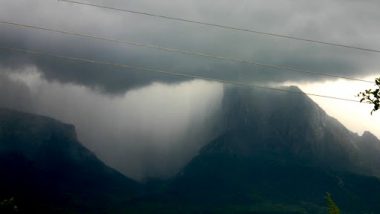New Delhi, June 29: Are cloudbursts that are increasingly affecting life in the Himalayan foothills linked to the forest fires? A recent study has found a connection between the formation of the tiny particles, the size of a cloud droplet on which water vapor condenses leading to the formation of clouds and forest fires. The number of such particles called the cloud condensation nuclei (CCNs) were found to have peaks associated with forest fire events.
Scientists from Hemvati Nandan Bahuguna (HNB) Garhwal University and IIT Kanpur jointly measured the activation of cloud condensation nuclei and studied its impact on high altitude cloud formation and complexity of local weather phenomenon under the influence of different weather condition in the ecologically sensitive regions of Central Himalayas for the first time. Uttarakhand Cloudburst: 15 Bodies Recovered in Uttarkashi, 20 People Still Missing.
Cloud condensation nuclei (CCN), which can activate and grow into fog or cloud droplets in the presence of supersaturation (SS) was measured by a droplet measurement technology’s (DMT) CCN Counter in the pristine Himalayan region at Himalayan Clouds Observatory (HCO), Swami Ram Tirtha (SRT) Campus of Hemvati Nandan Bahuguna (HNB) Garhwal University, Badshahithaul, Tehri Garhwal, Uttarakhand, India.
This observation was carried out under a Climate Change Programme Division, Department of Science & Technology (DST) funded project in collaboration with Hemvati Nandan Bahuguna (HNB) Garhwal University and IIT Kanpur, where the variation of CCN was reported on diurnal, seasonal, and monthly scale.
This first-time study published in the ‘Atmospheric Environment’ journal showed that the highest concentration of CCN was found to be associated with excessive fire forest activities of the Indian subcontinent. There were other peaks also associated with a variety of events, such as long-range transportation and local residential emission.
The study led by Alok Sagar Gautam from HNB Garhwal University Srinagar Uttarakhand and co-authored by SN Tripathi from Indian Institute of Technology, Kanpur, and Abhishek Joshi, Karan Singh, Sanjeev Kumar, R C Ramola from HNB Garhwal University Srinagar Uttarakhand can help improve the understanding of the complex mechanism of cloud burst, weather prediction and climate change condition over this region of Himalayas.
This research will be helpful in the source allocation of pollutants reaching the high-altitude regions of Garhwal Himalaya. Also, it will provide a better understanding for the cloud formation mechanism and weather extremities over this region.
(The above story first appeared on LatestLY on Jun 29, 2021 07:17 PM IST. For more news and updates on politics, world, sports, entertainment and lifestyle, log on to our website latestly.com).













 Quickly
Quickly












